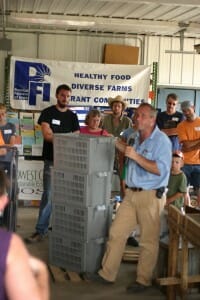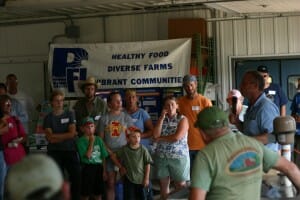Moving Stuff Around On The Market Farm: Rock Spring Farm’s Labor Saving And Profit Maximizing Devices With Chris Blanchard – PFI Field Day Report (Part 3 of 3)
Hand weeding with a wire weeder, push hoe, diamond hoe, wheel hoe, shovel/stirrup hoe, and a hoe
“You can never spend too much money on good hand tools.” – Chris Blanchard
Hoes come in all sizes, shapes, and methods of use. Training employees to use them correctly can improve their speed, comfort, and reduce a farm’s labor costs to get the job done. Chris adds “d-handles” to many of his hoes (available from Glacier Valley Enterprises, LLC) to keep his employees hands in a neutral, unbent position, key to reduce worker fatigue and to avoid carpel tunnel problems down the road.
When hoeing around drip tape, have a handy repair kit with all the tools employees need to repair small nicks in the plastic tubing. “We make it a task for all hoeing work to hook up drip tape to irrigation, turn it on, and repair all holes before the job is complete,” says Ben Kreuter, production manager at Rock Spring Farm.
“I recommend having a utility knife for every toolbox on the farm,” says Chris. “It is not worth your time to be digging around trying to find the farm’s only utility knife at 8:00 at night when you need to get your task done before dark.”
Labor Management
“Always try to externalize your knowledge so it gets done when you aren’t there.” – Chris Blanchard
Farm directives – Rock Spring Farm uses standardized forms for what work is to be done, including a list by order of importance, criteria for success (things people might forget) and goals (i.e. all weeds are to be removed from the ground and placed upside down so roots are exposed to the sun/air). Directives are placed on a clipboard, with a small map of the farm fields, with clearly written duties, what to do, how to do it, steps necessary in order to complete task and this is handed to the employee.
A whiteboard (8’x4’) for the packshed has been found to be very helpful at Rock Spring Farm. This captures a daily log of farmwork, including a list of employees present. It can be recorded easily by taking a photo of it each day. (Download photos to computer weekly or send daily with a smartphone). This recordkeeping is required for complying with Good Agricultural Practices (GAP), and organic certification inspection.
What is on Rock Spring Farm’s whiteboard?
- Who is working?
- What tasks will be done today, this week
- What are the readings on the walk-in cooler (Time, wet bulb, dry bulb, initials)
- Fence tester reading (joules)
- Numerical week of the year
- All the key things are in their place using magnets including clipboards (flat style), a fence tester, and a calculator with jumbo sized keys
- Two-way radios
- A big map of the farm and all fields (numbered)
Save labor in high tunnels
- Drywall stilts – Stand up and touch the rafters to work quickly and efficiently in the high tunnel
- Twine ring knives (available at Johnny’s) – trellis faster with a knife on your ring
- Max Tapener – Knot tying tool – speed up trellising (purchase at A.M. Leonard)
- Plastic greenhouse clips – hold plants to trellis twine (available at Johnny’s) – Chris recommends the black ones, they are UV tempered, and can be reused.
- Invest in peak vents with thermostatically controlled openers to control temperature automatically. “I buy myself time everyday especially in the mornings that I don’t need to be out here opening side walls manually to control temperature,” says Chris.
Cutting tools
“You can’t spend too much money on high quality harvest tools – they pay for themselves in enhanced employee productivity.” – Chris Blanchard
At Rock Spring farm, you will find industry standard asparagus knives with red whie and blue tape. Each tape is at a fixed measurement – 6”, 8”, and 10”. “I can tell my employees, we are harvesting Blue asparagus today, its easy, and fast,” Chris Blanchard.
Tools are kept razor sharp and employees are trained how to sharpen their tools safely. Sharpeners are in the packshed and out in the field with harvest crews. The speed of harvest can be significantly faster with a properly sharpened knife.
Scissors are all spring-loaded to avoid user fatigue and carpel tunnel injury. Chris also uses bread knives, restaurant industry standards, buying new ones each year due to their heavy use. “We pass them underneath one half inch of soil to get Chives to regrow without unsightly browning on the tips,” says Chris.
“We are in the business of moving things.” – Chris Blanchard
- Right-handed employees always should have their totes on the left side moving from right to left.
- Size garlic quickly, easily, and cheaply with a 2×4 and 6 nails arranged in pairs from largest, medium, and small.
 Hand carts – Many market farms have orders of products, smaller than by the full pallet load. For these orders, Chris recommends farms save time by modifying a dolly, and stacking four to six totes on mini pallets. Employees can slide the dolly easily underneath the mini pallet and tip it back to securely move the load from cooler to the transport vehicle.
Hand carts – Many market farms have orders of products, smaller than by the full pallet load. For these orders, Chris recommends farms save time by modifying a dolly, and stacking four to six totes on mini pallets. Employees can slide the dolly easily underneath the mini pallet and tip it back to securely move the load from cooler to the transport vehicle.
 Bulk dunking tank and a Jacuzzi bubbler – removing field heat quickly is essential to getting the highest quality produce. Chris recommends dunking in a bulk tank of cold water, and turning on a Jacuzzi bubbler for about 30-seconds to gently remove soil particles from the produce. “$150 for a bubbler, saves you a lot of money in employee time, hand lifting produce in a tank to remove dirt,” says Chris.
Bulk dunking tank and a Jacuzzi bubbler – removing field heat quickly is essential to getting the highest quality produce. Chris recommends dunking in a bulk tank of cold water, and turning on a Jacuzzi bubbler for about 30-seconds to gently remove soil particles from the produce. “$150 for a bubbler, saves you a lot of money in employee time, hand lifting produce in a tank to remove dirt,” says Chris.
“Concrete and wheels are the greatest labor savers there are! Put pallets under everything you can, and use your pallet jack!” – Chris Blanchard.
This concludes part three of a three-part blog series on Chris Blanchard’s field day in mid-July, 2012. Special thanks to our individual field day sponsors, the Midwest Organic and Sustainable Education Service (MOSES), and the Iowa Organic Association (IOA). Funding provided by the Ceres Foundation
